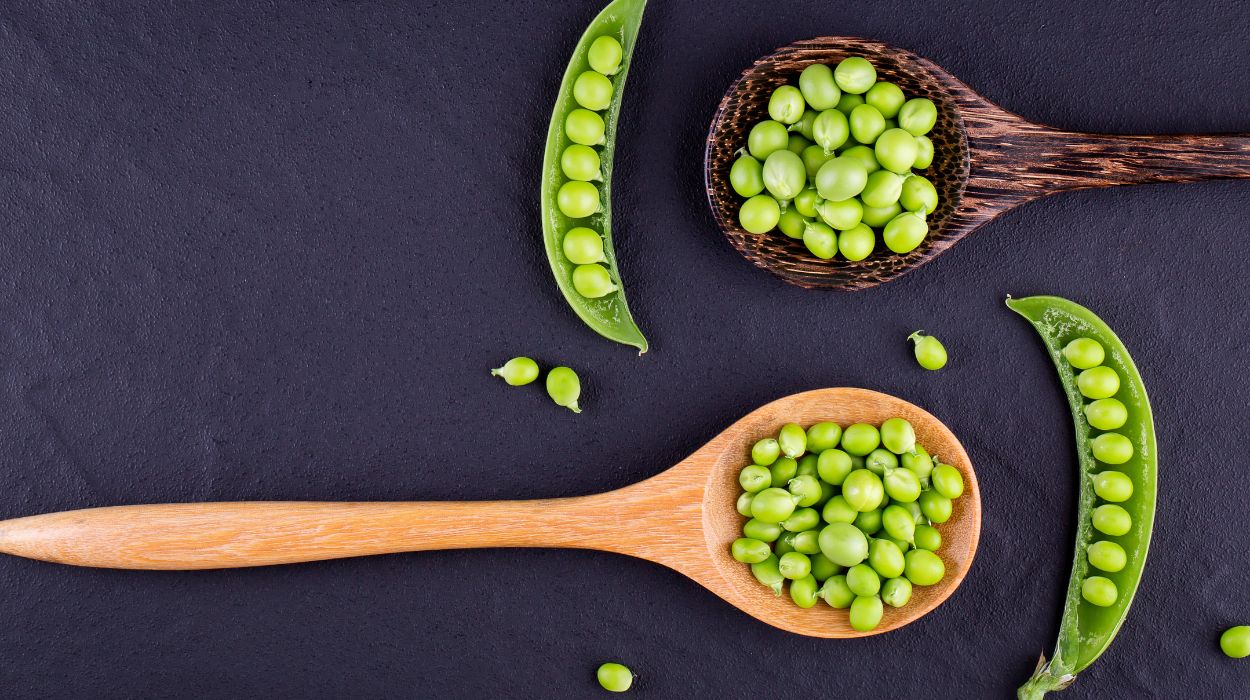 Expert's opinion
Expert's opinion
Expert's opinion
The article is a subjective view on this topic written by writers specializing in medical writing.
It may reflect on a personal journey surrounding struggles with an illness or medical condition, involve product comparisons, diet considerations, or other health-related opinions.
Although the view is entirely that of the writer, it is based on academic experiences and scientific research they have conducted; it is fact-checked by a team of degreed medical experts, and validated by sources attached to the article.
The numbers in parenthesis (1,2,3) will take you to clickable links to related scientific papers.
Are Lima Beans Good For You? Nutrition, Benefits & Downsides In 2024

The health benefits of the humble little lima bean were first discovered thousands of years ago. In fact, as far back as 1921, researchers were lyrical about its benefits! If you live in the Southern states of the U.S., you’ll probably know it better than the butter bean. But whichever name you choose to call it (or however you enjoy cooking it!), the impressive nutritional benefits will always be there for you to enjoy.
The best thing about this nutritionally power-packed legume is that it is cheap, easy to store and cook, and adds a buttery, textured quality to many dishes. That means that your family can always eat healthily, even on a tight budget. Better still, lima beans suit all diets – carnivorous, vegan, vegetarian, and gluten-free – and, if prepared correctly, even as part of a low-lectin, or lectin-free diet.
So let’s get straight to the facts – what exactly are lima beans, lima beans benefits, and side effects and how best can you integrate them into your diet in the healthiest and tastiest way possible?
Are Lima Beans Good For You?
The simple answer is yes — lima beans are very good for you. Adding them to any meal (particularly carbohydrate-rich ones) will lower[1] the overall glycemic index of that meal, lower the levels of the hormone ghrelin[2] (which stimulates hunger), keep your blood sugar levels stable, and make you feel fuller for longer.
Sprinkling some energy-dense lima beans over your lunch can also help to guard against heart disease and Type II diabetes,[3] helping with blood sugar control. And, while cheap, they can still match animal proteins in their positive effects on energy and athletic performance.[4] They are, in actuality, a fabulous source of high-quality protein, amongst many other nutrients.
What Are Lima Beans?

Lima beans[5] are large, flat, usually cream or green, kidney-shaped seeds. They are derived from the bean family and can also be brown, white, black, or purple. Whilst first forming a staple of Central American diets, they eventually became a favorite across many cultures, offering a powerful source of protein and fiber.
Lima beans were once considered a status symbol[6] in ancient South American cultures. In fact, as a prestigious representation of the bean warrior of the Moche warrior class, they even served as a powerful iconic metaphor for life and death.
In the present day, they are still respected, but more as a healthful alternative to meat and as a great source of nutrients! That’s why they continue to form the foundation for many dishes worldwide, offering a quick, easy way to make any meal more wholesome and nutritious. You’ll find them in most supermarkets and whole food stores packaged in canned, fresh, dried, or frozen form.
Lima Beans Nutrition Facts
Beans are already considered to be one of the healthiest food choices[7] out there by the Harvard T.H. Chan School of Public Health. And for a good reason.
Are lima beans healthy? According to the US Department of Agriculture,[5] 100 grams of lima beans contain around 123 calories, with an impressive 6.8 grams of protein and 5.4 grams of total fiber. That makes them a dense, nutrient-rich, low-energy food. Additionally, as lima beans contain only 1.16 grams of sugar, with a total of 23.6 grams of carbohydrates, they constitute a great dietary choice if you are trying to lose weight or maintain healthy blood pressure.
Further, with only 0.32 gram of fat, alongside 2.45 milligrams of iron, 32 mg of calcium, 74 mg of magnesium, 570 mg of potassium, and only 0.17 mg of sodium, lima beans ultimately offer a great high-nutrition, low-salt addition to any diet.
If cooked the right way, they are very low in lectins[8] (carbohydrate-binding proteins that can cause damage to our digestive health). They are also high in antioxidants,[9] which help to support a healthy immune system.
What Are Lima Beans Benefits?
There are so many great health benefits of lima beans that it’s hard to make a list. But we’ve managed to curate our top five right here. We’ll be covering price (how they suit any budget), weight loss (they may help give your diet a boost!), gut health, flexibility in suiting any diet (even a lectin-free one), and overall long-term health benefits (including heart health). So let’s get down to it!
Nutrition On A Budget
Canned beans are one of the cheapest and most easily accessible foodstuffs that you can buy (in fact, a 1-pound bag of raw lima beans will set you back less than $2 at some major supermarkets), offering an impressive bang for your buck!).
Canned, these awesome little legumes are easy to store, and transport and have a long shelf life. It is worth noting that the American Diabetes Association classifies beans as a superstar food, underscoring the potent nutritional profile of lima, and other beans, at a very impressive price. They also retain most of the nutritional value of fresh lima beans, too.
Ultimately, the great news is that no matter how tight our budget might be, we can still provide the high-quality nutrition that our families deserve if we regularly integrate legumes like lima beans into our diets.
Great For Weight Loss
As a food high in fiber and protein, lima beans are a great choice for dieters. That is because eating a diet with a higher fiber intake has been shown to predict fat loss.[10] Similarly, a high protein intake has been observed to[11] lower food cravings while also actively lowering levels of the hunger-promoting hormone ghrelin.[12] Lima beans are high in both fiber and protein whilst also being very low in sugar and fat, making them an excellent all-around choice for weight loss.
They Help To Promote Gut Health
Beans have been observed, in a recent 2022 study,[13] to provide notable prebiotic benefits, including increased levels of good bacteria in the gut, boosted short-chain fatty-acid production in the colon, and better overall health. The health benefits[14] of a healthier gut are far-reaching, and range from a stronger immune system to more energy and even better mental health.
Now, you might have avoided beans partly as a dietary choice due to their infamous flatulent-creating reputation. A recent scientific study[15] reported, however, that reports of flatulence from eating beans may have been exaggerated, so perhaps it is time to give them a chance!
The anti-inflammatory[16] properties of beans are also well-documented, with their lipid-lowering and nutrient-absorption effects clear.
They Are A Great Lectin-Free Food (When Cooked)
Lectins are present in almost a third of our food and can sometimes resist the digestive process, entering our circulation directly. According to research,[8] the result of this process can, for some susceptible individuals, be the onset of nutrient deficiencies, serious damage to the intestinal wall, and poor digestion.
While raw lima beans are high in lectin, washing, and then boiling them can completely remove or disable lectins. Lima beans thus offer a healthy low-lectin or lectin-free dietary option when prepared correctly.
They Protect Your Long-Term Health
A recent academic review[17] reported that lima beans help to keep blood sugar levels stable and positively aid in the management of Type II Diabetes. Diets high in beans have also been observed to lower low-density lipoprotein (the bad cholesterol) cholesterol, positively mediate risk factors associated with metabolic syndrome, and reduce the overall risk of diabetes and coronary heart disease.
Lima Beans Side Effects

So, we’ve seen the many positive benefits of lima beans. But can lima beans ever be bad for you?
Well, anything can be bad for you if not eaten in moderation, and lima beans are no exception. That’s mostly because they come packed with fiber. Whilst fiber carries many benefits, if we ingest too much too quickly for our systems to adjust, we can expect unpleasant side effects[18] like stomach cramps, constipation or diarrhea, gas, and bloating. The key is to eat small amounts and slowly increase intake over time.
Beans also contain lectins, which can cause digestive and other health-related issues. However, as noted earlier, we can easily remove lectins from lima beans. Let’s take a closer look at what you need to know.
How To Cook And Eat Lima Beans
How to cook lima beans? The most important task in the preparation phase is to wash them.[19] Sounds obvious, right?
Right. But aside from the common sense factor (washing food can eliminate bacteria), we know that lectin is water soluble and can therefore be removed easily from the bean’s surface by washing it. Soaking and boiling the beans will also remove lectins, meaning that you can enjoy them alongside other lectin-free superfoods as part of a low-lectin or lectin-free diet.
Another piece of great news is that pulse proteins like lima beans are comparable[4] with animal proteins when it comes to stimulating higher levels of athletic performance. This is partly because they provide an impressive range of essential amino acids. That makes them a great meat substitute for anyone interested in gaining the protein that meat can provide without any of the saturated fat content.
Lima Bean Inspiration
Then, on to the fun part – eating them!
We recommend adding cooked lima beans to any high carbohydrate-based meal (like spaghetti). That’s because they offer an easy and tasty way to lower the total glycemic index[4] score of the dish. That will help to keep your blood sugar[20] levels stable, and you won’t feel as tired or sluggish after eating. And their cream texture will enrich any meal! A related tip – try to avoid lima beans that have been pre-prepared in sodium or sugar for maximum health benefits.
Stuck for inspiration? Consider a butter bean and chorizo stew for your evening dinner, a creamy butter bean mash, or hearty butter bean soup with crusty brown bread on the side for dipping (spices optional!). Or simply substitute your usual side of fries for butter beans for an instant health hit.
Ultimately, these versatile little legumes can add a textured, creamy quality to liven up, or add a twist to many traditional dishes – so relying on them for a nutritional boost doesn’t mean that you have to compromise taste.
Conclusion
The famed ancient mathematician and philosopher Pythagoras famously believed that beans have a soul.[21] While we might not be prepared to take that quote entirely literally, one thing we know is that. A steaming hot bowl of butter beans, cooked to perfection, and added to your favorite dish, can certainly feed your soul! And it’ll feed your immune system, too.
+ 21 sources
Health Canal avoids using tertiary references. We have strict sourcing guidelines and rely on peer-reviewed studies, academic researches from medical associations and institutions. To ensure the accuracy of articles in Health Canal, you can read more about the editorial process here
- Bello-Pérez, L.A., Sáyago-Ayerdi, S.G., Chávez-Murillo, C.E., Agama-Acevedo, E. and Tovar, J. (2007). Proximal composition andin vitro digestibility of starch in lima bean (Phaseolus lunatus) varieties. Journal of the Science of Food and Agriculture, [online] 87(14), pp.2570–2575. doi:10.1002/jsfa.3005.
- Ramírez-Jiménez, A.K., Reynoso-Camacho, R., Tejero, M.E., León-Galván, F. and Loarca-Piña, G. (2015). Potential role of bioactive compounds of Phaseolus vulgaris L. on lipid-lowering mechanisms. Food Research International, [online] 76, pp.92–104. doi:10.1016/j.foodres.2015.01.002.
- Castañeda-Pérez, E., Jiménez-Morales, K., Castellanos-Ruelas, A., Chel-Guerrero, L. and Betancur-Ancona, D. (2021). Antidiabetic Potential of Protein Hydrolysates and Peptide Fractions from Lima Bean (Phaseolus lunatus L): An In Vitro Study. International Journal of Peptide Research and Therapeutics, [online] 27(3), pp.1979–1988. doi:10.1007/s10989-021-10226-8.
- Shevkani, K., Singh, N., Patil, C., Awasthi, A. and Paul, M. (2022). Antioxidative and antimicrobial properties of pulse proteins and their applications in gluten‐free foods and sports nutrition. International Journal of Food Science & Technology, [online] 57(9), pp.5571–5584. doi:10.1111/ijfs.15666.
- Usda.gov. (2023). FoodData Central. [online] Available at: https://fdc.nal.usda.gov/fdc-app.html#/food-details/169135/nutrients.
- Usda.gov. (2016). Lima Beans | National Agricultural Library. [online] Available at: https://www.nal.usda.gov/collections/stories/lima-beans.
- The Nutrition Source. (2012). Carbohydrates. [online] Available at: https://www.hsph.harvard.edu/nutritionsource/carbohydrates/.
- Vojdani A (2015). Lectins, agglutinins, and their roles in autoimmune reactivities. Alternative therapies in health and medicine, [online] 21 Suppl 1. Available at: https://pubmed.ncbi.nlm.nih.gov/25599185/.
- Messina, V. (2014). Nutritional and health benefits of dried beans. The American Journal of Clinical Nutrition, [online] 100(suppl_1), pp.437S442S. doi:10.3945/ajcn.113.071472.
- Miketinas, D.C., Bray, G.A., Beyl, R.A., Ryan, D.H., Sacks, F.M. and Champagne, C.M. (2019). Fiber Intake Predicts Weight Loss and Dietary Adherence in Adults Consuming Calorie-Restricted Diets: The POUNDS Lost (Preventing Overweight Using Novel Dietary Strategies) Study. The Journal of Nutrition, [online] 149(10), pp.1742–1748. doi:10.1093/jn/nxz117.
- Leidy, H.J. (2014). Increased dietary protein as a dietary strategy to prevent and/or treat obesity. Missouri medicine, [online] 111(1), pp.54–8. Available at: https://www.ncbi.nlm.nih.gov/pmc/articles/PMC6179508/.
- Blom, W.A., Lluch, A., Stafleu, A., Vinoy, S., Holst, J.J., Schaafsma, G. and Hendriks, H.F. (2006). Effect of a high-protein breakfast on the postprandial ghrelin response. The American Journal of Clinical Nutrition, [online] 83(2), pp.211–220. doi:10.1093/ajcn/83.2.211.
- Kadyan, S., Sharma, A., Arjmandi, B.H., Singh, P. and Nagpal, R. (2022). Prebiotic Potential of Dietary Beans and Pulses and Their Resistant Starch for Aging-Associated Gut and Metabolic Health. Nutrients, [online] 14(9), p.1726. doi:10.3390/nu14091726.
- Bioengineered. (2016). Beneficial Microbes: The pharmacy in the gut. [online] Available at: https://www.tandfonline.com/doi/full/10.1080/21655979.2015.1126015.
- Winham, D.M. and Hutchins, A.M. (2011). Perceptions of flatulence from bean consumption among adults in 3 feeding studies. Nutrition Journal, [online] 10(1). doi:10.1186/1475-2891-10-128.
- Hijová, E., Bertková, I. and Štofilová, J. (2019). Dietary fibre as prebiotics in nutrition. Central European Journal of Public Health, [online] 27(3), pp.251–255. doi:10.21101/cejph.a5313.
- Bielefeld, D., Grafenauer, S. and Rangan, A. (2020). The Effects of Legume Consumption on Markers of Glycaemic Control in Individuals with and without Diabetes Mellitus: A Systematic Literature Review of Randomised Controlled Trials. Nutrients, [online] 12(7), p.2123. doi:10.3390/nu12072123.
- NHS Trust (2020). Reducing Dietary Fibre. [online] Available at: https://www.sath.nhs.uk/wp-content/uploads/2020/09/Reducing-dietary-fibre.pdf.
- The Nutrition Source. (2019). Lectins. [online] Available at: https://www.hsph.harvard.edu/nutritionsource/anti-nutrients/lectins/#:~:text=%5B6%5D%20Lectins%20are%20water%2D,disables%20the%20action%20of%20lectins.
- Milton Keynes University Hospital. (2021). Glycaemic Index (GI) – Milton Keynes University Hospital. [online] Available at: https://www.mkuh.nhs.uk/patient-information-leaflet/glycaemic-index-gi.
- Huffman, C. (2018). Pythagoras (Stanford Encyclopedia of Philosophy). [online] Stanford.edu. Available at: https://plato.stanford.edu/entries/pythagoras/.



